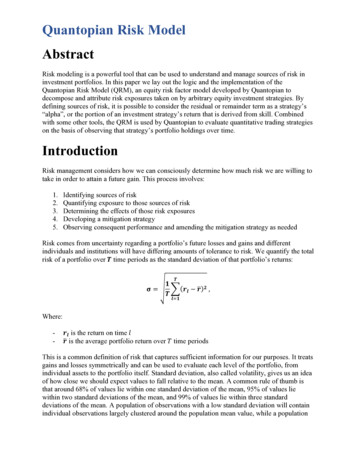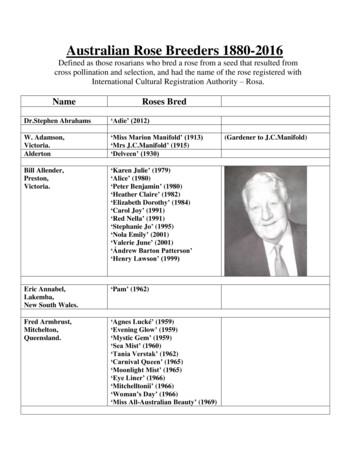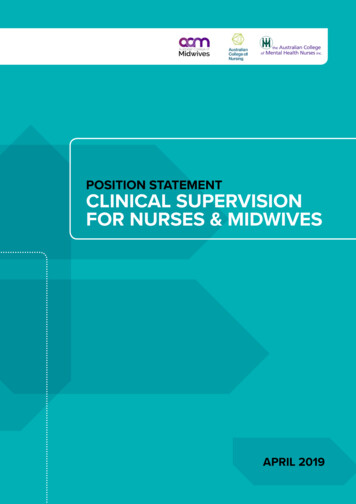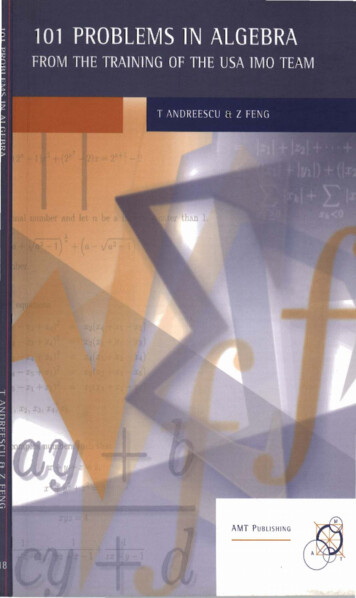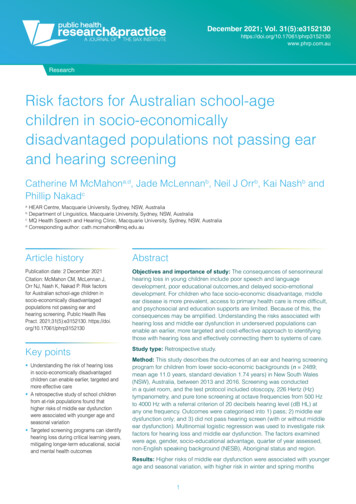
Transcription
December 2021; Vol. www.phrp.com.auResearchRisk factors for Australian school-agechildren in socio-economicallydisadvantaged populations not passing earand hearing screeningCatherine M McMahona,d, Jade McLennanb, Neil J Orrb, Kai Nashb andPhillip NakadcabcdHEAR Centre, Macquarie University, Sydney, NSW, AustraliaDepartment of Linguistics, Macquarie University, Sydney, NSW, AustraliaMQ Health Speech and Hearing Clinic, Macquarie University, Sydney, NSW, AustraliaCorresponding author: cath.mcmahon@mq.edu.auArticle historyAbstractPublication date: 2 December 2021Citation: McMahon CM, McLennan J,Orr NJ, Nash K, Nakad P. Risk factorsfor Australian school-age children insocio-economically disadvantagedpopulations not passing ear andhearing screening. Public Health ResPract. 2021;31(5):e3152130. https://doi.org/10.17061/phrp3152130Objectives and importance of study: The consequences of sensorineuralhearing loss in young children include poor speech and languagedevelopment, poor educational outcomes,and delayed socio-emotionaldevelopment. For children who face socio-economic disadvantage, middleear disease is more prevalent, access to primary health care is more difficult,and psychosocial and education supports are limited. Because of this, theconsequences may be amplified. Understanding the risks associated withhearing loss and middle ear dysfunction in underserved populations canenable an earlier, more targeted and cost-effective approach to identifyingthose with hearing loss and effectively connecting them to systems of care.Key pointsStudy type: Retrospective study. Understanding the risk of hearing lossin socio-economically disadvantagedchildren can enable earlier, targeted andmore effective care A retrospective study of school childrenfrom at-risk populations found thathigher risks of middle ear dysfunctionwere associated with younger age andseasonal variation Targeted screening programs can identifyhearing loss during critical learning years,mitigating longer-term educational, socialand mental health outcomesMethod: This study describes the outcomes of an ear and hearing screeningprogram for children from lower socio-economic backgrounds (n 2489;mean age 11.0 years, standard deviation 1.74 years) in New South Wales(NSW), Australia, between 2013 and 2016. Screening was conductedin a quiet room, and the test protocol included otoscopy, 226 Hertz (Hz)tympanometry, and pure tone screening at octave frequencies from 500 Hzto 4000 Hz with a referral criterion of 20 decibels hearing level (dB HL) atany one frequency. Outcomes were categorised into 1) pass; 2) middle eardysfunction only; and 3) did not pass hearing screen (with or without middleear dysfunction). Multinomial logistic regression was used to investigate riskfactors for hearing loss and middle ear dysfunction. The factors examinedwere age, gender, socio-educational advantage, quarter of year assessed,non-English speaking background (NESB), Aboriginal status and region.Results: Higher risks of middle ear dysfunction were associated with youngerage and seasonal variation, with higher risk in winter and spring months1
Public Health Research & Practice December 2021; Vol. 31(5):e3152130 https://doi.org/10.17061/phrp3152130Risk factors for school children not passing ear and hearing screening in Australia(July–September and October–December, compared with January–March).There were no differences between those from NESB and those with Englishas a first language, between the Aboriginal population and non-Aboriginalpopulation, or between those who resided within or outside a major city. Stronger partnerships across health andeducation can support children withhearing loss and those at risk of hearinglossConclusion: More than one in 10 school-age children from lower socioeconomic backgrounds experience hearing loss (11.5%). Targeted ear andhearing screening programs offer an opportunity to identify hearing lossduring critical learning years and seasons, mitigating longer-term effects oneducation, and social and mental health.Introductionof some degree – substantially higher than the rate inother high-income countries7; most of which is conductivehearing loss. These figures may be influenced by highrates of otitis media (OM) observed in populations inAustralia with limited access to healthcare – includingAboriginal and Torres Strait Islander children (hereinreferred to as Aboriginal). A retrospective study of earand hearing screening data conducted between 1998and 2004 in three primary schools in Western Australiashowed that up to 42% of Aboriginal children living inurban areas had middle ear disease, and 19.1% ofall children exhibited hearing loss8, more than doublethe rate in the non-Indigenous population.9 Prevalencerisk of middle ear disease and hearing loss typicallyincreases with remoteness. However, a comparativestudy of 408 urban and 438 regional Aboriginal primaryschool children (aged 3–15 years) from Western Australiashowed evidence of OM in 30.7% of the urban cohort and15.5% of the regional cohort.10 Other studies have shownthat up to 91% of Aboriginal children living in very remoteareas have a middle ear abnormality.11The recently launched World Health OrganizationWorld Report on Hearing12 recommends that all countriesimplement school screening programs to ensureThroughout a child’s early years, undetected hearing lossduring the critical period of neurocognitive developmentcan have significant consequences for their speech andlanguage development, educational achievement, andneurocognitive and social–emotional growth.1-3Newborn hearing screening programs can reduce theburden of congenital hearing loss on the individual andsociety by mitigating many downstream effects.4 However,approximately half of childhood hearing loss remainsundetected by such programs5, either because of theinsensitivity of the test in detecting milder forms of hearingloss or because of progressive or infection-relatedhearing loss. Australian data showing the age of firsthearing aid fitting of children with permanent hearing loss(who are eligible for fully subsidised hearing services untilthe age of 26 years) support this. Two predominant peakscan be seen: 1) within the first year of life, attributed to thesuccess of newborn hearing screening; and 2) a broaderpeak observed across the early educational years (seeFigure 1; data shown for 20206).A recent systematic review estimated that 3.4–12.8%of Australian primary school children have hearing lossFigure 1. Number of Australians with permanent hearing loss aged 0–25 years first fitted with hearing aids, 2020400Number of children first fitted350300250200150100500012Source: Hearing Australia6345678910111213Age (years)2141516171819202122232425
Public Health Research & Practice December 2021; Vol. 31(5):e3152130 https://doi.org/10.17061/phrp3152130Risk factors for school children not passing ear and hearing screening in Australiaquarter of the year in which they were tested – is shown inTable 1.early detection of ear disease and hearing loss. Thecurrent absence of these programs can be attributedto the costs associated with administering screeningprograms and the relative perceived benefit of newbornhearing screening programs already in place in manyhigh-income countries.13,14 Universal preschool orschool-based hearing screening programs may not beeconomically viable and may be logistically burdensomein high-income countries such as Australia.15 However,targeted screening of populations with lower levels ofsocio-economic advantage may provide a more costeffective approach to identifying hearing loss and middleear dysfunction where the risks of these conditionsare high.16 Certainly, there is an unequal burden of eardisease and hearing loss in children from lower socioeconomic settings.17 The combination of increasedprevalence and increased cumulative duration of livingwith middle ear disease is likely to pose significant risksfor educational outcomes. For example, Aboriginalchildren up to 14 years of age experience cumulativemiddle ear disease for approximately 2 years across theirlifetime, compared with approximately 2 months for nonIndigenous children.9Australian Bureau of Statistics data18 show that, in2018, Aboriginal children made up 5.9% of the total childpopulation (0–14 years) and about 1 in 5 of all childrenlived in the lowest socio-economic areas (in 2017).Targeted solutions can alleviate the social and economicburden for individuals, their families and society. Thisretrospective study aimed to determine the risk of middleear dysfunction, and not passing a hearing screeningtest, in 2489 school-age children attending a charitybased program providing health and wellbeing servicesfor underserved populations.Referral pathwaysReferrals for health checks were managed centrallyby the charity-based organisation to ensure that allresults where a child did not pass were integrated intoa single referral before they were sent to the child’sgeneral practitioner (GP), family and/or other healthproviders. Referral pathways for hearing and middleear checks were as follows: 1) children with middle eardysfunction who did not pass the hearing screen weredirectly referred to their GP and advised to have a fullaudiological assessment after medical review of middleear function; 2) children with normal middle ear functionwho did not pass the hearing screen were directlyreferred to Hearing Australia (an Australian Governmenthearing services agency for people with permanenthearing loss from 0–26 years of age); and 3) children withmiddle ear dysfunction who passed the hearing screenwere provided with a letter to their GP requesting amedical review of middle ear function.Study designAudiometric screenings were administered bypostgraduate audiology students under the directsupervision of a professionally accredited audiologist.Screenings were conducted in two quiet rooms withinthe centre, and noise levels were recorded daily usinga sound level meter; levels were consistently lowerthan the maximum sound pressure levels allowable forbackground noise in audiometric rooms. A Hiene Mini3000 Otoscope and an Interacoustics Titan MiddleEar Analyzer Tympanometer were used to conductotoscopy and tympanometry. An Interacoustics AD629Eaudiometer and passive attenuating Sennheiser HDA200headphones were used for audiometry. Results forotoscopy were qualitatively recorded. The normativevalues used for tympanometry were adapted from Jergerclassification guidelines for adults – that is, ear canalvolume of 0.5–2 cm3, static compliance 0.2–1.8 cm3and middle ear pressure –150 daPa (decapascals).A screening level of 20 decibels hearing level (dB HL)was selected for audiometry, and the tested frequencieswere 500, 1000, 2000 and 4000 hertz (Hz). Each childwas presented with an initial 60 dB HL tone followed by a40 dB HL presentation and three consecutive 20 dB HLpresentations at each frequency in each ear. A passwas defined when the child responded correctly totwo of the three presentations at 20 dB HL at all testedfrequencies, in both ears. If the child failed to respond tothe two screening presentations at any frequency, theirthreshold was determined using the standard Hughson–Westlake technique. Children were deemed to havefailed screening audiometry if their threshold exceeded20 dB HL at any frequency, in either ear.MethodParticipantsThe retrospective study included consecutive hearing andmiddle ear screening data from children who attendeda 12-day on-site, away-from-home educational programdelivered by a charity-based organisation in a centrallocation in Greater Sydney, New South Wales (NSW),Australia, between January 2013 and December 2016.Children from lower socio-economic backgrounds wereselected by their school to participate in the program,which was designed to develop social and emotionalskills, build self-esteem and improve overall wellbeing.Children were provided with dental, optical, hearingand medical screening and treatment during their stay.All demographic information was extracted from anelectronic database located on-site, and the data arefrom children who attended hearing screening only once.Demographic information – that is, age, sex, Aboriginalstatus, non-English speaking background (NESB),ICSEA (a measure of socio-educational advantage)19 and3
Public Health Research & Practice December 2021; Vol. 31(5):e3152130 https://doi.org/10.17061/phrp3152130Risk factors for school children not passing ear and hearing screening in AustraliaTable 1. Participant characteristics and outcomes (N 2489)CharacteristicPassn (%)Risk of hearing lossn (%)Middle ear dysfunctionn (%)Total5–9384 (56.2)84 (12.3)215 (31.5)68310–141077 (60.8)197 (11.1)497 (28.1)177115–1824 (68.6)4 (11.4)7 (20.0)351485 (59.7)285 (11.5)719 (28.9)2489Male711 (59.2)137 (11.4)353 (29.4)1201Female773 (60.1)148 (11.5)366 (28.4)128714842857192488Age (years)TotalSexTotalMissing11ICSEA (25th percentiles)1 (1007–1193) (highest)306 (57.7)66 (12.5)158 (29.8)5302 (958–1006)322 (59.9)59 (11.0)157 (29.2)5383 (910–957)326 (62.0)57 (10.8)143 (27.2)5264 (582–909) (lowest)324 (59.1)56 (10.2)168 ginal and Torres Strait IslanderYes394 (57.9)83 (12.2)203 (29.9)680No1091 (60.3)202 (11.2)516 (28.5)180914852857192489Yes142 (63.1)24 (10.7)59 (26.2)225No1343 (59.3)261 (11.5)660 (29.2)226414852857192489Major city838 (58.1)170 (11.8)435 (30.1)1443Outside major city645 (61.8)115 (11.0)284 (27.2)104414832857192487TotalNon-English speaking backgroundTotalRegionTotalMissing22Time testedJan–Mar251 (64.0)40 (10.2)101 (25.8)392Apr–JunJul–Sep419 (62.0)74 (10.9)183 (27.1)676509 (57.2)104 (11.7)277 (31.1)890Oct–Dec306 (57.6)67 (12.6)158 (29.8)531Total14852857192489Total1485 (59.7)285 (11.5)719 (28.9)2489ICSEA Index of Community Socio-Educational Advantage194
Public Health Research & Practice December 2021; Vol. 31(5):e3152130 https://doi.org/10.17061/phrp3152130Risk factors for school children not passing ear and hearing screening in AustraliaStatistical analysis(Table 2), significant seasonal differences were foundbetween the July–September quarter and January–Marchquarter for the likelihood of failing hearing screening whentested (OR 1.96, 1 df; 95% confidence interval [CI] 1.17,3.4; p 0.02), and between the October–December andJanuary–March quarters (OR 2.08, 1 df; 95% CI 1.16,3.7; p 0.01). Significant seasonal differences werealso found in the likelihood of being diagnosed withmiddle ear dysfunction in July–September comparedwith in January–March (OR 1.49, 1 df; 95% CI 1.05, 2.1;p 0.02). Further, children with middle ear dysfunctionwere younger (around 0.9 years) than those who passedthe hearing test (age in years: OR 0.91, 1 df; 95% CI 0.85,0.96; p 0.001). Multicollinearity was tested for, and nomulticollinear relationships were found in independentvariable pairs.No significant differences were found in either middleear dysfunction or not passing the hearing screen forthose living within or outside major cities, identifying asAboriginal, from NESB, for school ICSEA value, or for sexfor either middle ear dysfunction or hearing loss.Frequencies, means and proportions were calculatedto ascertain the characteristics of the study sample.Multinomial logistic regression was used to investigaterisk factors for two ear conditions: hearing loss andmiddle ear disease. One outcome variable with threelevels was used in the analysis. The levels were ‘passed’and hearing loss or middle ear dysfunction, with‘passed’ being the reference category. The predictorvariables were entered in one step, with continuousvariables entered as factors and categorical variables ascovariates. Odds ratios (ORs), 95% confidence intervalsand p values were calculated for each predictor variable.All statistical tests were two tailed, with alpha 0.05.Statistical analyses were performed using IBM SPSSVersion 26 (IBM Corporation, Armonk, New York).Ethics approvalParental consent was obtained for all children tocomplete hearing screening as part of a general healthcheck. Because of the retrospective analysis, directparental consent for children to participate in this studywas waived, and the project was approved by theMacquarie University Human Research Ethics Committee(#5201700248).DiscussionTo better understand the factors associated with riskof failing an ear and hearing screening program, weassessed 2489 children as part of an integrated healthcheck for children from underserved populations. Theresults suggest that middle ear dysfunction is more likelyto occur in younger children and that there is seasonalvariation, with a higher risk of failing hearing screeningand having middle ear dysfunction in the later quarters ofthe year (July–September [winter–spring] and October–December [spring–summer]). This has implicationsfor targeting resources for ear and hearing screeningto maximise opportunities to address ear diseaseand hearing loss as soon as possible, particularly inpopulations with lower socio-economic advantage.Although relatively few studies have assessedoutcomes of school ear and hearing screening programsin Australia compared with other high-income countries,results of the current study are in line with three otherAustralian studies (discussed in a systematic review).7Minor differences between the studies in the pass/fail rates of hearing screening (with 11.5% not passingthe hearing screen in the current study) are likely to beattributable to differing screening test levels, with failurerates decreasing with an increase in threshold levels(dB HL) used to define the pass/fail criteria for referralfor hearing loss. Similarly, differences in rates of middleear dysfunction between the current study (28.9%) andthose conducted previously in Australia (17.9%20 and18.5%21) are the result of different normative values formiddle ear pressure. It is difficult to compare estimatesof the prevalence of hearing loss in school-age childrenbecause test protocols, diagnostic criteria, and age rangeResultsParticipants comprised 2489 children (51.7% female)aged 5.5–17.4 years (mean age 11.0 years, standarddeviation [SD] 1.74). Of these, 27.3% identified asAboriginal, and 9% were from NESB. When reported,participants were generally from below-average socioeducational advantage schools (there were 347 missingvalues). Median ICSEA value was 957.0 (SD 81.9); 50%of the schools that children attended had ICSEA valuesin the range 528–957. ICSEA values are calculated ona scale that has a median of 1000 and an SD of 100.ICSEA values typically range from approximately 500(representing extremely educationally disadvantagedbackgrounds) to about 1300 (representing schoolswith students with very educationally advantagedbackgrounds).19 Approximately 58% of children werefrom a major city. Similar numbers of children weretested during three of the quarters of the year; a higherproportion was tested between July and September(35.8%).Of the 2489 children tested, more than 40% (n 1004)did not pass the hearing screening assessment.Participants were grouped into three subcategoriesbased on their results: 1) pass; 2) did not pass hearingscreen with or without middle ear dysfunction; and3) current middle ear dysfunction alone. Overall,285 children (11.5%) did not pass the hearing screen,and 719 (28.9%) presented with middle ear dysfunctionalone. In the multinomial logistic regression model5
Public Health Research & Practice December 2021; Vol. 31(5):e3152130 https://doi.org/10.17061/phrp3152130Risk factors for school children not passing ear and hearing screening in AustraliaTable 2. Multinomial logistic regression model predicting hearing test outcomesaOdds ratio95% CIp valueOutcomebVariables in modelHearing test not passedAge (in years)0.940.87, 1.0230.15ICSEA191.0010.99, 1.0030.45Time of year of test- January–MarchRef- April–June1.59, 1 df0.88, 2.90.13- July–September1.96, 1 df1.17, 3.430.02- October–December2.08, 1 df1.16, 3.70.010.67, 1.20.390.72, 1.370.950.73, 1.390.96MaleRefFemale0.89, 1 dfAboriginal and Torres Strait IslanderNon-Aboriginal and Torres Strait IslanderRef0.99, 1 dfPlace of residence- Outside major cityRef- Major city1.009, 1 dfNESBMiddle ear dysfunction- YesRef- No0.84, 1 df0.51, 1.380.49Age (in years)0.91, 1 df0.85, 0.960.001ICSEA1.0, 1 df0.99, 1.0010.29Time of year of test- January–MarchRef- April–June1.25, 1 df0.86, 1.810.25- July–September1.49, 1 df1.05, 2.120.02- October–December1.41, 1 df0.98, 2.040.060.75, 1.10.310.83, 1.30.770.91, 1.430.240.54, 1.070.12MaleRefFemale0.91, 1 dfAboriginal and Torres Strait IslanderNon-Aboriginal and Torres Strait IslanderRef1.03, 1 dfPlace of residence- Outside major cityRef- Major city1.15, 1 dfNESB- YesRef- No0.76, 1 dfCI confidence interval; ICSEA Index of Community Socio-Educational Advantage; NESB non-English–speaking background; Ref reference groupaThe overall model was statistically significant, indicating that the model predicted the outcome better than chance (χ2 32.96, 18 df;p 0.017).bReference group for model is ‘passed test’ (i.e. not referred for hearing loss or middle ear disease).6
Public Health Research & Practice December 2021; Vol. 31(5):e3152130 https://doi.org/10.17061/phrp3152130Risk factors for school children not passing ear and hearing screening in AustraliaConclusionsof those tested vary across studies; however, similarestimates have been observed elsewhere. For example,cross-sectional population-based findings from the2012–2013 Canadian Health Measures Survey (n 2434after exclusions; age range 6–19 years) showed that 7.7%had any hearing loss.22 A systematic review of children(age range 3–19 years) with hearing loss 25 dB HLfrom the US showed that the average prevalence of anyhearing loss was 3.1%, ranging from 1.7% to 5.5%23,with increasing prevalence for lower-income households.A cross-sectional survey of primary school students inZimbabwe (age unspecified) with screening thresholds of 30 dB HL showed a prevalence rate of 2.4% (95%CI 2.0, 2.8), with sensorineural hearing loss found in 1.0%of children.24In this study, age was a significant predictor for themiddle ear dysfunction group; lower rates of middle eardysfunction were seen with increasing age, consistentwith previous studies.17,22 This may be a function of thedownwards shift in the orientation of the eustachian tubewith age, which increases the efficiency of drainageof the middle ear. For example, a study conducted inIran compared conductive hearing loss rates in schoolchildren in grades 1–5, and the results revealed adecrease in rates with an increase in grade level.25 On theother hand, in the current study, age was not a predictorfor hearing loss. A similar finding was demonstratedin a population of school-age children in the SolomonIslands26, although other studies have found anassociation between younger age and hearing loss.5,27Seasonal differences in middle ear disease areconsistent with previous studies, which have revealedhigher rates of middle ear dysfunction in winter andspring months.27 Higher rates of OM have been identifiedin winter because of the association with colds and otherrespiratory infections, and higher rates of OM, abnormalmiddle ear pressure and eustachian tube dysfunctionhave been identified in spring because of the increasein hayfever and pneumonia cases.28 It is important tonote that there was no difference in risk between thosewho self-identified as Aboriginal and non-Aboriginalchildren. The risk of middle ear disease is associated withsocial determinants of health, and is therefore higher inIndigenous children, refugees, children in remote areasand those in low-income countries.15,17 Within Australia,region (major city versus elsewhere) was not identifiedas a predictor for either hearing loss or middle eardysfunction. However, the assessment of remotenesswas broadly categorised and based on schools’ locationsrather than the location of the children’s homes, whichis a limitation of the current study. Further limitationsinclude the lack of information about other exposurefactors for children, such as exposure to cigarette smokeand overcrowding that may be associated with higherrates of middle ear disease and hearing loss.29 AlthoughICSEA data was missing for 347 of 2489 participants, thevery tight confidence intervals suggests that this wouldprobably not significantly affect the outcomes.OM and hearing loss are more prevalent in populationswith lower levels of social and economic advantage,including those living in rural or remote areas, FirstNations populations, and low-income households.17Even mild hearing loss, often not detected by parentsbut the most common hearing loss resulting from OM30,is associated with educational risk.31 Coupled withother risks of poorer educational outcomes in thesepopulations, OM increases the likelihood of reduced earlyeducational outcomes.32 The impact of the coronavirusdisease 2019 (COVID-19) pandemic in disruptingclassroom learning may widen the gap in the future.School hearing screening programs can effectivelyidentify those with middle ear disease and hearingloss early, although the cost-effectiveness of rolling outsuch programs across a population remains debatedand poorly understood.33 Nonetheless, targetingopportunities for middle ear and hearing screening basedon the increased educational risks of an individual, ora population attending a school in an area at increasedrisk of educational disadvantage, could reduce the costsof implementing screening programs. Programs couldbe provided for children in the early years of schooling( 5 years of age), such as preschool or the beginningof primary school. Targeted screening programs couldbe further improved by giving teachers informationabout how to detect a child at risk and when the risk ofmiddle ear disease and hearing loss is greatest, enablinggreater opportunities for putting in place surveillance andeducational supports.For screening or surveillance programs to be effective,a robust pathway to care must exist so that childrenwho are detected with ear and hearing problems havean accessible pathway to treatment and the necessarysupport. Strengthened partnerships across healthand education are important to support a child withhearing loss or at risk of hearing loss from middle eardisease. Schools can optimise a child’s access tolearning with cost-effective supports, including priorityseating at the front of the classroom, behaviouralmanagement strategies to reduce classroom noise, andclassroom amplification systems. Scaffolding childhooddevelopment in the early years provides significantbenefits to the individual, the family and society.Peer review and provenanceExternally peer reviewed, invited. CMM is a Guest Editorof this themed issue of Public Health Research & Practice.She had no part in the peer-review process for this paper.Competing interestsNone declared.7
Public Health Research & Practice December 2021; Vol. 31(5):e3152130 https://doi.org/10.17061/phrp3152130Risk factors for school children not passing ear and hearing screening in AustraliaAuthor contributions10. Timms L, Grauaug S, Williams C. Middle ear diseaseand hearing loss in school-aged Indigenous WesternAustralian children. Asia Pacific Journal of SpeechLanguage and Hearing. 2012 Dec 1;15(4):277–90.CM was responsible for the drafting, analysis of data,writing and editing of the manuscript. JM was responsiblefor the design, drafting, preliminary analysis of data,writing and editing of the manuscript. NO was responsiblefor overseeing the data analysis and preliminary analysisof the data. KN was responsible for undertaking acomprehensive literature search, reviewing and editingthe manuscript. PN was responsible for the design,overseeing the collection of data, providing analyticaladvice, reviewing and editing the manuscript.11. Couzos S, Metcalf S, Murray RB. Systematic review ofexisting evidence and primary care guidelines on themanagement of otitis media in Aboriginal and Torres StraitIslander populations. Canberra: Australian GovernmentDepartment of Health and Aged Care; 2001 [cited 2021Oct 27]. Available from: researchonline.jcu.edu.au/37363/12. World Health Organisation. World report on hearing.Geneva: Switzerland; 2021 [cited 2021 Oct 27] Availablefrom: ringReferences13. Ross DS, Holstrum WJ, Gaffney M, Green D, Oyler RF,Gravel JS. Hearing screening and diagnostic evaluationof children with unilateral and mild bilateral hearing loss.Trends Amplif. 2008;12(1):27–34.1. Carney AE, Moeller MP. Treatment efficacy: hearing lossin children. J Speech Lang Hear Res. 1998;41(1):S61–84.2. Celesia G, Hickok G. Neurocognitive development incongenitally deaf children. In: Aminoff MJ, Boller F,Swaab DF (eds). The human auditory system:fundamental organization and clinical disorders. London:Elsevier; 2015:335.14. Wang C, Bovaird S, Ford-Jones EL, Bender R,Parsonage C, Yau M, et al. Vision and hearing screeningin school settings: reducing barriers to children’sachievement. Paediatr Child Health. 2011;16(5):271–2.3. Kennedy CR, McCann DC, Campbell MJ, Law CM,Mullee M, Petrou S, et al. Language ability after earlydetection of permanent childhood hearing impairment.N Eng J Med. 2006;354(20):2131–41.15. Molloy C, Wake M, Poulakis Z, Barker M, Goldfeld S.Models for screening and surveillance of hearing inearly childhood: Identification and review of evidenceand efficiency. Sydney: NSW Government; 2014 [cited2021 Jul 17]. Available from: ents/models-for-screeningand-surveillance.pdf4. Wake M, Ching TY, Wirth K, Poulakis Z, Mensah FK,Gold L, et al. Population outcomes of three approachesto detection of congenital hearing loss. Pediatrics.2016;137(1).16. Karunanayake CP, Albritton W, Rennie DC, Lawson JA,McCallum L, Gardipy PJ, et a
economic backgrounds experience hearing loss (11.5%). Targeted ear and hearing screening programs offer an opportunity to identify hearing loss during critical learning years and seasons, mitigating longer-term effects on education, and social and mental health. Introduction Figure 1. Number of Australian






